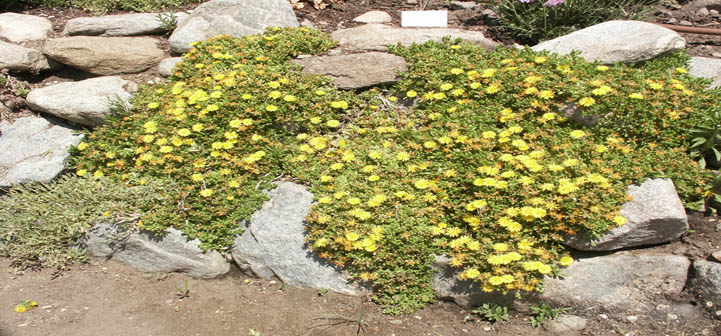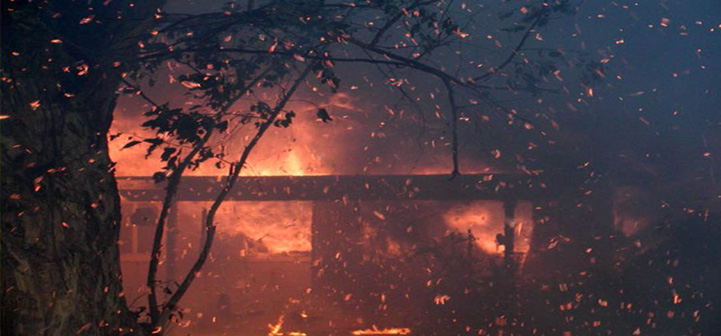
Firewise Plant Characteristics
Firewise plants have a number of characteristics in common, but also can vary considerably. Below are some important points about these plants and their management.
- No plant is fireproof. All will burn in a very intense fire.
- Firewise plants all have one or more of these firewise characteristics:
- Tissues contain more moisture, especially during the fire season.
- Tissues contain low amounts of volatile oils and other readily flammable chemicals.
- Plants provide less fuel, either by producing less litter or by staying small.
- Plants are compact or low to the ground, so they can be used in the landscape to interrupt fire pathways.
- All trees provide large amounts of fuel to a fire, so they should be carefully placed and maintained. Most broadleaved trees are less flammable than conifers (pines, firs, spruces, junipers), though there are major exceptions to this rule.
- Most firewise plants do well in open, sunny areas typical of most fire prone sites.
- Some firewise plants need minimal or no irrigation to remain green and healthy; over-irrigation may harm such plants or may cause them to grow too fast and become hazardous. Other plants will need supplemental water to survive. Know your plants’ needs and habits so you can use and manage them appropriately.
- When choosing a particular plant species or cultivar for a firewise planting, favor those that stay low to the ground and are compact, green and healthy, with low maintenance and minimal water, especially during the dry season.
- All firewise plants should receive periodic maintenance, including removal of dead leaf and stem material within the crown and on the ground, pruning to keep crowns clean and high (in trees), and removal of individual plants to break up fuel continuity.
- Make sure that the plants you are considering are cold-hardy in your area (check the USDA hardiness zone for the plant and compare it to the zone for your area) and otherwise well-suited for your locale and the specific planting site.
- Some plants are weedy and may even be illegal to plant or cultivate.
Using Native Plants
Using firewise plants native to your landscape often is the best option. Native plants may survive better, rarely are weedy, and may do well with little or no additional water or other resources. The important point is to know plants and your site well enough to choose plants appropriate to your site. Remember, just because a plant is native to your state doesn’t mean it is well adapted or native to your local area. Aspen, for example, is native to the mountains in much of the West, but not to warmer, drier valleys. So while aspen is a western native, it is not a good landscape choice away from the mountains.
Plants to Avoid
Some plants are pyrophytic – these plants are extremely flammable due to high resin or oil content or other characteristics. Common tree pyrophytes are junipers, pines, firs, and spruces. Do not plant these species in your firewise landscape, especially near the home, or use them sparingly. If they are already present, consider replacing them with some of the firewise species listed here. If you decide to keep a pyrophytic plant in your landscape, keep it pruned and thinned, remove dead material regularly, and keep it at least 15 feet from any structure or other plants. Cheatgrass is an invasive, pyrophytic grass in the west that should be mowed and gotten rid of if possible.
Grasses
Low-growing grasses are useful anywhere in a firewise landscape, and can serve well as your primary landscape plants. Keep grasses well watered, and mowed or trimmed. In especially dry areas, consider using buffalograss or other grasses that require less water and are slow growing. Also look for grasses that are less prone to drying out during the summer.
Ground Covers
Low-growing ground covers make effective firewise plants, especially near the home. Ground covers often are succulent or have other firewise characteristics that make them useful, functional, and attractive. When planted in beds surrounded by walkways and paths, in raised beds, or as part of a rock garden, they are an effective barrier to fire spread. The best ground cover is a spreading plant which forms a dense mat of roots and foliage that reduces soil erosion while excluding weeds. Maintain ground covers by providing adequate irrigation, and clipping off and removing dead stems and other litter annually.
Herbaceous Perennials
Herbaceous perennials in your landscape will add color and variety. However, tall perennials can present some fire danger if allowed to dry out. To reduce fire hazard, plant herbaceous perennials in widely spaced beds. As with ground covers, separate beds with gravel walkways, rock walls or areas of mown lawn. Do not plant these perennials next to structures unless they are small in stature, frequently watered and weeded, and the tops are removed after they dry out. Keep all perennial beds watered, and prune away dead stalks and foliage throughout the summer and fall.
Shrubs and Woody Vines
Shrubs add color and structure to a well-designed landscape. However, shrubs are a special concern in a firewise landscape, because they can be a source of significant fuel. Additionally, if shrubs are planted under tree crowns, under overhanging decks or adjacent to buildings, they can function as a fire ladder to spread flames to new areas. When planning your firewise landscape, plant shrubs individually, or plant in small clumps apart from each other. Near trees and buildings, plant only widely separated, low-growing, non-resinous varieties. Mow grass low around shrubs, and trim away dead leaves and branches annually.
Trees
Any tree provides a large potential source of fuel for a wildfire, so include trees in your firewise landscape sparingly. Nearer the home trees should be small and placed so that there crowns will be at least 10 to 15 feet away from structures. Leave plenty of room between trees to allow for growth; keep 10 feet between mature tree crowns. Prune tree limbs up to a height of 8 to 15 feet above the ground, and do not allow shrubs to grow up under the trees, creating ladder fuels.
Broadleaved (deciduous) trees are better firewise choices than conifers. Deciduous trees have higher moisture content, less flammable chemical content, and provide less fuel during their dormant period. Most conifers have flammable resins, and their dry needles can drop and accumulate on roofs and the ground, giving fire a place to start and a way to spread. A few firewise trees are listed below, but there are many others. Just remember, any tree provides a lot of fuel, so trees should be used carefully in a firewise landscape.
More Information
For more information on landscaping for fire safety check the following links:
eXtension Articles on Landscape and Defensible Space
Firewise Landscaping by Utah State University
Fire Performance Plant Selector: Eastern United States Fire Performance Plant Selector
Article Written by:
Michael Kuhns, Utah State University, Logan, UT

